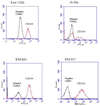Innate immune responses of primary murine macrophage-lineage cells and RAW 264.7 cells to ligands of Toll-like receptors 2, 3, and 4
- PMID: 19732955
- PMCID: PMC2888975
- DOI: 10.1016/j.cimid.2009.07.001
Innate immune responses of primary murine macrophage-lineage cells and RAW 264.7 cells to ligands of Toll-like receptors 2, 3, and 4
Abstract
Although studies have been performed to characterize responses of macrophages from individual anatomical sites (e.g., alveolar macrophages) or of murine-derived macrophage cell lines to microbial ligands, few studies compare these cell types in terms of phenotype and function. We directly compared the expression of cell surface markers and functional responses of primary cultures of three commonly used cells of monocyte-macrophage lineage (splenic macrophages, bone marrow-derived macrophages, and bone marrow-derived dendritic cells) with those of the murine-leukemic monocyte-macrophage cell line, RAW 264.7. We hypothesized that RAW 264.7 cells and primary bone marrow-derived macrophages would be similar in phenotype and would respond similarly to microbial ligands that bind to either Toll-like receptors 2, 3, and 4. Results indicate that RAW 264.7 cells most closely mimic bone marrow-derived macrophages in terms of cell surface receptors and response to microbial ligands that initiate cellular activation via Toll-like receptors 3 and 4. However, caution must be applied when extrapolating findings obtained with RAW 264.7 cells to those of other primary macrophage-lineage cells, primarily because phenotype and function of the former cells may change with continuous culture.
Copyright 2009 Elsevier Ltd. All rights reserved.
Conflict of interest statement
The authors do not have any conflict of interest that would bias this manuscript.
Figures



Similar articles
-
Distinct osteoclast precursors in the bone marrow and extramedullary organs characterized by responsiveness to Toll-like receptor ligands and TNF-alpha.J Immunol. 2003 Nov 15;171(10):5130-9. doi: 10.4049/jimmunol.171.10.5130. J Immunol. 2003. PMID: 14607912
-
TRIM38 Negatively Regulates TLR3/4-Mediated Innate Immune and Inflammatory Responses by Two Sequential and Distinct Mechanisms.J Immunol. 2015 Nov 1;195(9):4415-25. doi: 10.4049/jimmunol.1500859. Epub 2015 Sep 21. J Immunol. 2015. PMID: 26392463
-
Dysregulated Toll-like receptor expression and signaling in bone marrow-derived macrophages at the onset of diabetes in the non-obese diabetic mouse.Int Immunol. 2006 Jul;18(7):1101-13. doi: 10.1093/intimm/dxl045. Epub 2006 May 25. Int Immunol. 2006. PMID: 16728431
-
Toll-like receptor-induced inflammatory cytokines are suppressed by gain of function or overexpression of Gα(i2) protein.Inflammation. 2012 Oct;35(5):1611-7. doi: 10.1007/s10753-012-9476-z. Inflammation. 2012. PMID: 22581266 Free PMC article.
-
Funiculosin variants and phosphorylated derivatives promote innate immune responses via the Toll-like receptor 4/myeloid differentiation factor-2 complex.J Biol Chem. 2017 Sep 15;292(37):15378-15394. doi: 10.1074/jbc.M117.791780. Epub 2017 Jul 28. J Biol Chem. 2017. PMID: 28754693 Free PMC article.
Cited by
-
A Photoresponsive Hyaluronan Hydrogel Nanocomposite for Dynamic Macrophage Immunomodulation.Adv Healthc Mater. 2019 Feb;8(4):e1801234. doi: 10.1002/adhm.201801234. Epub 2018 Dec 7. Adv Healthc Mater. 2019. PMID: 30537061 Free PMC article.
-
Autophagy Induction by a Small Molecule Inhibits Salmonella Survival in Macrophages and Mice.Antimicrob Agents Chemother. 2019 Sep 9;63(12):e01536-19. doi: 10.1128/AAC.01536-19. Epub 2019 Oct 7. Antimicrob Agents Chemother. 2019. PMID: 31591121 Free PMC article.
-
Immune cell type, cell activation, and single cell heterogeneity revealed by label-free optical methods.Sci Rep. 2019 Nov 19;9(1):17054. doi: 10.1038/s41598-019-53428-3. Sci Rep. 2019. PMID: 31745140 Free PMC article.
-
Heteroleptic Ruthenium Polypyridyl Complex Had Differential Effects on the Production of Pro-inflammatory Cytokines TNFα, IL1β, and IL6 by the Mammalian Macrophages In Vitro.Inflammation. 2019 Aug;42(4):1383-1388. doi: 10.1007/s10753-019-00999-y. Inflammation. 2019. PMID: 30848409
-
In vitro models and ex vivo systems used in inflammatory bowel disease.In Vitro Model. 2022;1(3):213-227. doi: 10.1007/s44164-022-00017-w. Epub 2022 Apr 25. In Vitro Model. 2022. PMID: 37519330 Free PMC article. Review.
References
-
- Corradin SB, Mauel J, Gallay P, Heumann D, Ulevitch RJ, Tobias PS. Enhancement of murine macrophage binding of and response to bacterial lipopolysaccharide (LPS) by LPS-binding protein. J Leukoc Biol. 1992;52:363–368. - PubMed
-
- Suda Y, Kirikae T, Shiyama T, Yasukochi T, Kirikae F, Nakano M, Rietschel ET, Kusumoto S. Macrophage activation in response to S-form lipopolysaccharides (LPS) separated by centrifugal partition chromatography from wild-type LPS: effects of the O-polysaccharide portion of LPS. Biochem Biophys Res Commun. 1995;210:678–685. - PubMed
-
- Nozawa RT, Yanaki N, Yokota T. Cell growth and antimicrobial activity of mouse peritoneal macrophages in response to glucocorticoids, choleragen and lipopolysaccharide. Microbiol Immunol. 1980;24:1199–1209. - PubMed
-
- Aderem A. Role of Toll-like receptors in inflammatory response in macrophages. Crit Care Med. 2001;29:S16–S18. - PubMed
Publication types
MeSH terms
Substances
Grants and funding
LinkOut - more resources
Full Text Sources
Other Literature Sources

